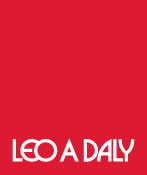Recent Articles
Case study: the workplace of the future
In a world where change is the only constant, the workplace demands a flexible, real time response to the needs of occupants.
“The Workplace of the Future” is a research project, design exploration and tactical implementation that seeks to synthesize a response to the many changes in workplace that have happened since the beginning of the pandemic. Through our research process, we expanded the scope to include a wider range of changes in workplace, understanding that these trends were merely accelerated by COVID-19 and the massive global experiment of work-from-home. Though this started as a question about “returning to the office” it quickly became clear that we must rethink the office wholesale.
Our key finding: the workplace of the future cannot be static. It must respond dynamically to a world where change is the only constant. This can be achieved through a workplace strategy that includes comprehensive change management, facilitated by design, as a holistic partnership. To “return to work,” we must enable new ways of working while leveraging design that builds culture, breeds innovation and responds constantly and continuously to user needs.
Our effort is detailed in the following blog, in the video above and in the PDF at the very bottom of this post.
How we got here
For us, this effort started with a basic, practical question: how will we, as architects, planners, engineers and interior designers, work together after the pandemic is over? For the last 15 months, we’ve worked mainly at home, embracing a set of digital collaboration tools by necessity, and learning ways of working together.
At the same time, many of our clients were asking the same question about their own workplaces. Is there a strong reason to return to the office post-pandemic? (Spoiler: yes) Do we always need to be in the office? (Often, no). If not, when will we need to be in the office, when can we work from home, and how should these questions change how we design the space?
As we considered these questions through a design lens, we noticed that most of them were in existence before the pandemic came about. Existing trends in technology, culture, business, the environment, and generational change have been slowly exerting their push and pull on the people and spaces that make up the workplace for decades. The pandemic merely accelerated these changes, became a tipping point. As we looked to define “the workplace of the future” It became clear to us that we are not just responding to COVID. Rather, are responding to a new normal in which change is constant.
Our analysis
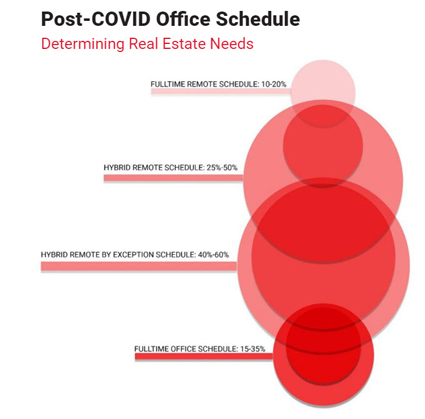 We started our study by surveying a handful of representative clients, from small start-ups to Fortune 100 companies, to learn what their workplace policies might look like post-pandemic. What we saw was consistent with what we’ve experienced ourselves: a hope to retain the positive aspects of work-from-home and reclaim the positive aspects of workplace culture.
We started our study by surveying a handful of representative clients, from small start-ups to Fortune 100 companies, to learn what their workplace policies might look like post-pandemic. What we saw was consistent with what we’ve experienced ourselves: a hope to retain the positive aspects of work-from-home and reclaim the positive aspects of workplace culture.
15-35% of those we surveyed are planning a complete return to pre-pandemic ways of working – that is, everyone working centrally from an office. For everyone else, the future of work is hybrid. 10-20% of companies are going 100% remote. 25-50% are including remote work at least some of the time. 40-60% will allow remote work by exception.
So what does that mean for design? What is the role of the office if some or all of your workforce is working at home, either some or all of the time? How do you create camaraderie? How can the workplace provide more utility to employees? How does it benefit employers? If the workplace is to continue, how should it be organized? And how do we manage that space over time to accommodate and flex to new and unpredictable usage patterns?

Why do we come to work?
In a hybrid workplace, the office must cater directly to the needs of users. So what do employees need? And how can we give it to them?
Our findings:
- We come to the office to be a company. The workplace provides an irreplaceable venue to meet with business contacts, to gather with each other in a social capacity, and to enable the little interactions that lay the groundwork of what we call culture. Responding to this need, the living room is the front door of the company, providing space for meetings and the more casual connections that often genera new ideas, spread information information, and initiate partnerships that might not otherwise occur.
- We come to the office to collaborate. Zoom is fine, and it will likely be a part of our workflow forever, but it’s not a replacement for the energy and camaraderie that comes from being together and tackling a challenge as a team. Lab space is where we innovate. These spaces allows for small and large team meetings, celebrations and collaboration.
- We come to the office to get down to business. The home office is cozy. Who doesn’t like the leisure of working from the porch or taking a powernap between mind-numbing conference calls. But when it comes down to it, we rely on the office to put our heads down and work. It’s an under-acknowledged fact that innovation is 10% collaboration and 90% grinding. Nothing facilitates intense creative focus like an office. In response to this need, office space provides a task-driven atmosphere conducive to work, as well as sensitive and confidential meetings.
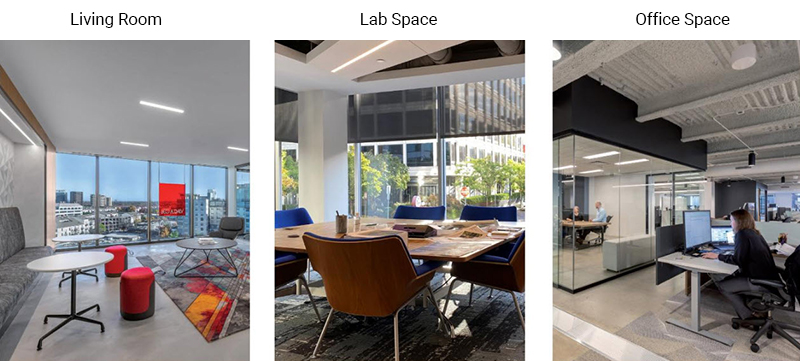
Time changes everything
With these parts in mind, we next turned our attention to the overarching influence of time on the design and function of the workplace of the future. In a world where change is constant and schedules are flexible, the workplace needs the ability to recalibrate constantly. In a hybrid workplace, some days will be intensely collaborative. Some will be dense with independent work. Some days will include all-hands meetings, and others will hold important meetings with clients. As time changes its demands on workers, the workplace must adjust on a short, medium and long-term basis.
As employees converge and disperse between home and office over time, the workplace responds dynamically along a continuum of flexibility.
Our design response:
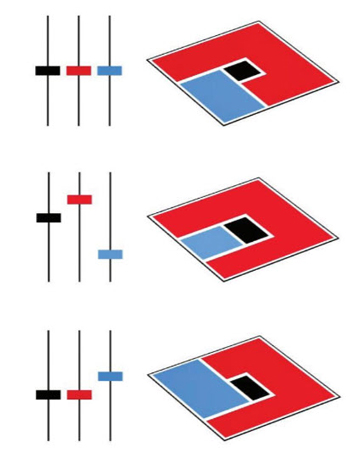 Starting with the three elements of living room, lab and office, we overlayed the element of time and considered the workplace as an eminently reconfigurable machine. Think of your home stereo. Depending on the type of music you’re listening to, you might recalibrate the EQ to bring out the frequencies that sound best. In this way, we thought of tuning the workplace to daily, weekly and monthly needs. Some things will need to remain fixed, but most of the space will need to shift constantly between living room, lab and office space, performing well in each function, but ready to switch to another if needed.
Starting with the three elements of living room, lab and office, we overlayed the element of time and considered the workplace as an eminently reconfigurable machine. Think of your home stereo. Depending on the type of music you’re listening to, you might recalibrate the EQ to bring out the frequencies that sound best. In this way, we thought of tuning the workplace to daily, weekly and monthly needs. Some things will need to remain fixed, but most of the space will need to shift constantly between living room, lab and office space, performing well in each function, but ready to switch to another if needed.
Organizing this dynamic ecosystem, we came to see three new ways of defining design interventions in the workplace of the future.
- Fixed Elements are strategically placed elements intended to stay put. They set the stage for the flexibility that surrounds them. Along the continuum of flexibility, several elements will be fixed. This may include a kitchen, a certain number of enclosed offices and infrastructural needs.
- Recalibration Elements are semi-fixed – not intended to be moved every day but to change over time. In order to minimize the footprint of fixed elements we design semi-fixed, adaptable elements. These may include a demountable wall or partition that would be easy to renovate one, two or five years into the future.
- Tunable Elements can be easily reconfigured by the user – daily, hourly, on a whim. Workers themselves, as the people occupying the space, can control and tune these elements for their specific needs on a day-to-day basis.
Knowing these three parameters allows us to then specify the right arrangement of spaces and design elements to allow living room, lab and office spaces to perform as needed over time.
Tactical implementation
Our next step was to apply this methodology to a real-life project. What better way than to start in one of our own studios? This design research project began as an effort to answer the question of how we will continue to collaborate and transform the built environment as designers in our LEO A DALY studios. The answer lies in the above ideas and their expression in response to our functional needs.
Our practical case study includes visible and invisible design tactics aimed at optimizing the return to and redefinition of the workplace to enhance culture, collaboration and innovation.
Visible design tactics
- Visible dashboarding for quality and health monitoring and space usage benchmarking
- Flex acoustics and lighting engineering
- Reclaiming real estate to enhance company growth while reducing cost expenditures
Invisible design tactics
- Ongoing change management communication
- Workplace strategy based on a company’s needs over time
The clip below, as well as the video at the top of this post, do the best job of explaining the intentionality, tactical expression and functional impact of these design strategies. You will see a variety of spaces tweak and unfold to enable a variety of activities within the workplace. These examples include living room, lab, and office space, all configured along a continuum of flexibility from fixed to tunable. Using this configuration, the workplace is transformed into something of high utility to employees, enabling a return to work that retains the flexibility of work-from-home, facilitating the rebuilding of company culture and the continuation of innovative, collaborative work.
About the authors

Kristina Crawley, AIA, NCARB, LEED AP, our global commercial practice leader, has nearly two decades of experience in commercial mixed-use, hospitality, retail, restaurant and workplace design in the United States and abroad, including commercial and mixed-use projects from Shanghai to South Korea to Dubai. With a passion for contextual design and placemaking, Kristina has published several articles on resilience, international architectural responses to climate change and post-disaster reconstruction.

Daniel Yudchitz, AIA, NCARB, LEED AP, director of design in our Minneapolis studio, has 18 years of experience designing projects of all scales. His approach is rooted in the belief that architecture is about allocating resources strategically to achieve maximum impact. Creating meaningful architectural expression within the boundaries of time and budget, while discovering opportunities for design impact that transcend those limitations, is key to his philosophy.
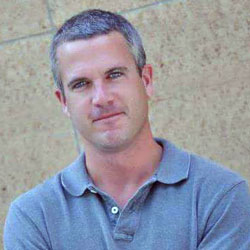
Andrew Ransavage is an associate and computer animation specialist in our Minneapolis studio. Andrew’s expertise in CG imagery and animation production have been used for everything from design analysis to finished quality marketing materials. His ability to translate clients ideas into a virtual reality allows design concepts and options to be fully explored. He works with the latest in advanced 3D modeling and digital multimedia applications and will be responsible for developing visualization and animation materials for the project.
